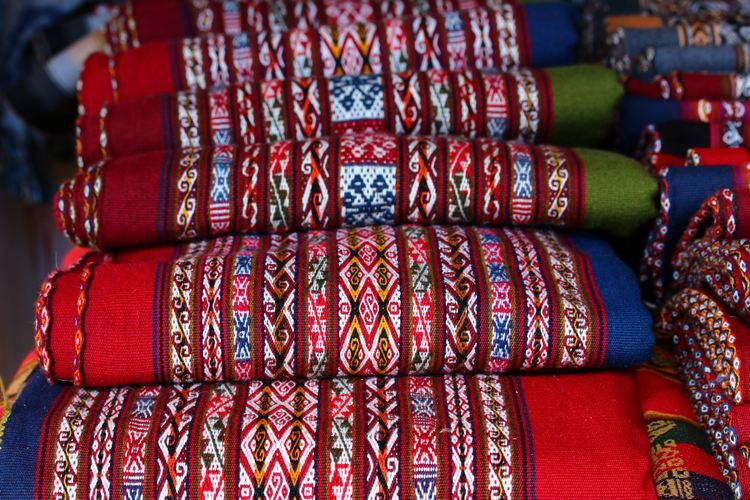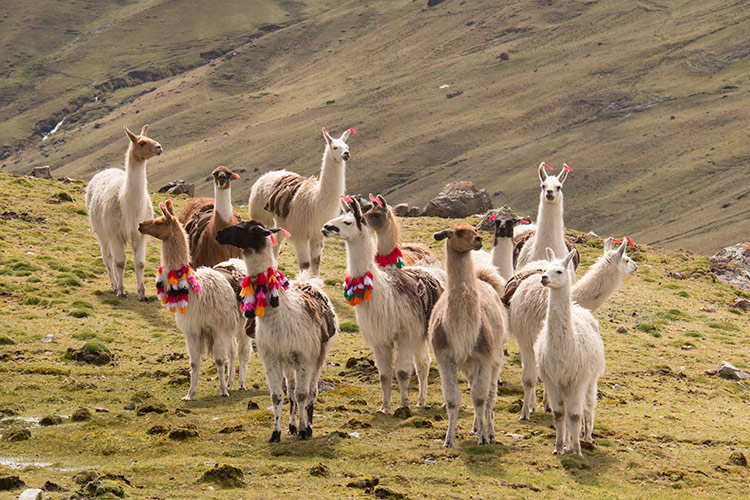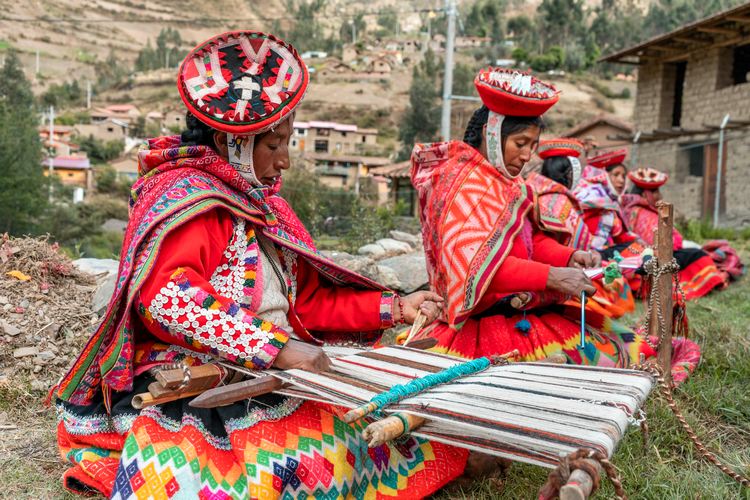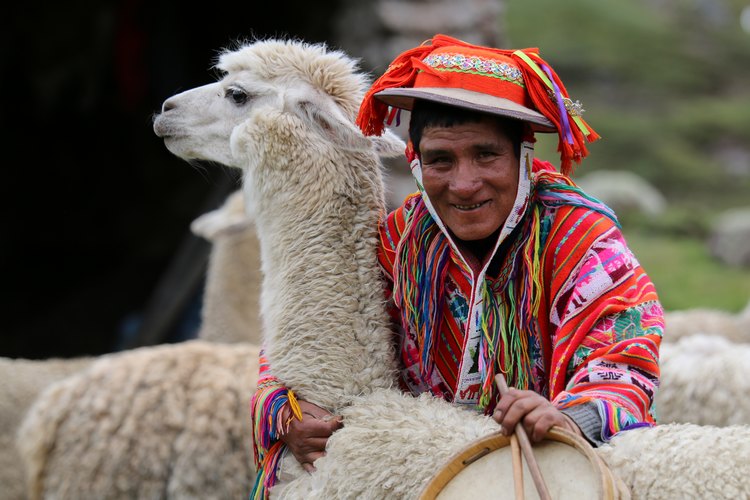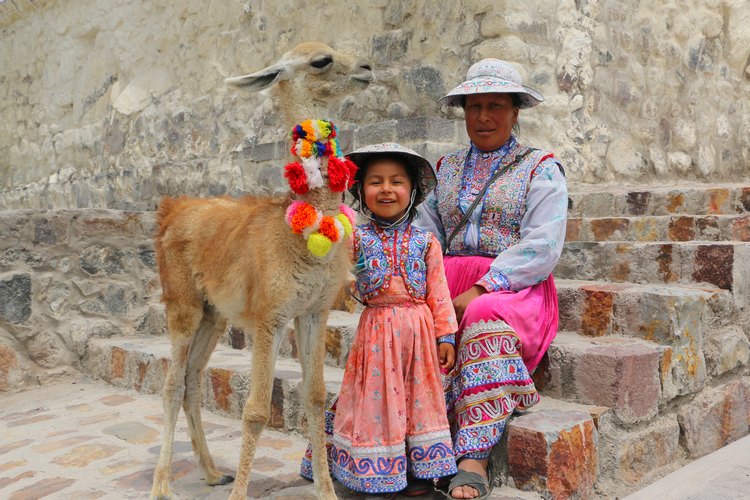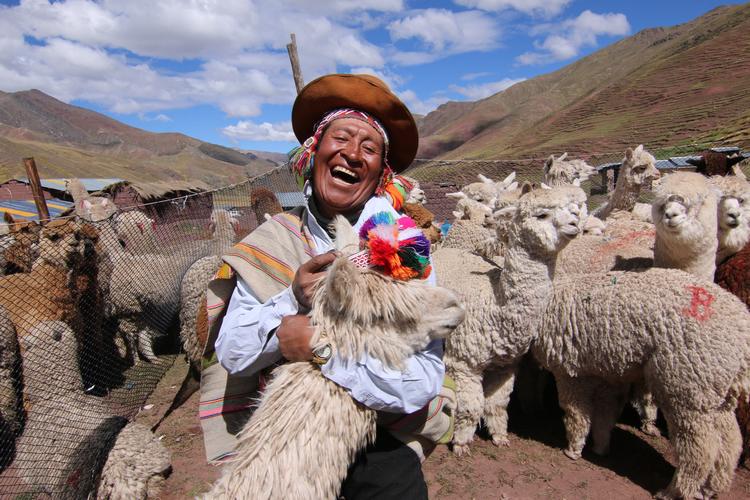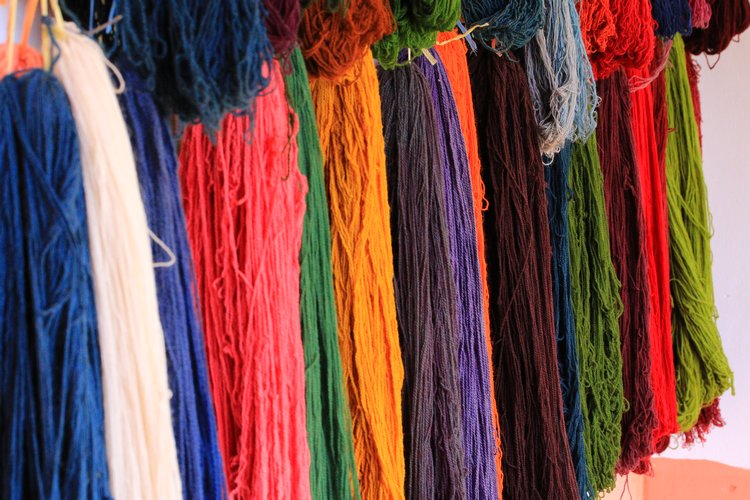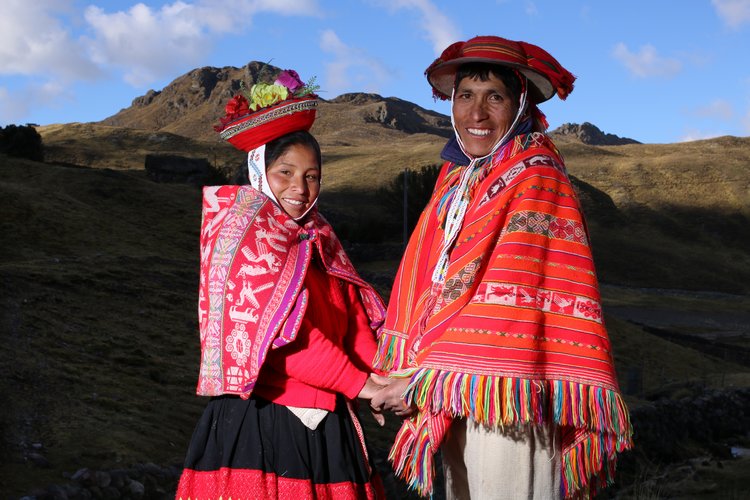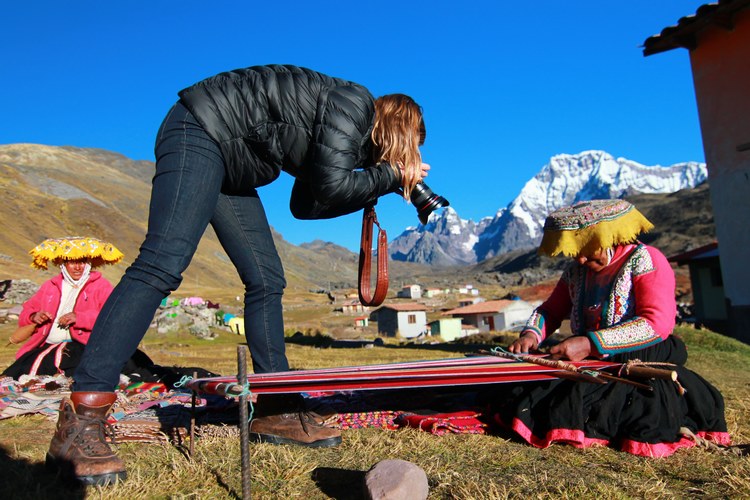Hand-woven textiles have been an integral element of Peruvian culture for thousands of years. Traditionally, textiles were not only utilized as clothing and status symbols, but were also created specifically as sacred cloths in which the dead were buried. Textiles have remained a predominant Peruvian art form, and over the centuries weavers developed original and unique styles, designs and techniques. Furthermore, some weavers have reinvented ancestral designs in contemporary forms to meet modern-day needs. These textile arts are extremely labor intensive, and consume enormous amounts of wool. The Peruvian textiles are full of vibrant, hand-dyed colors, which are a key aspect of Andean aesthetics, as the local people still maintain the tradition of using these bright and beautiful colors as their regular clothing.
Peruvian Textile History
Peru holds the World Record for the longest continual history of textile production, dating back a staggaring 10,000 years. Invented many eons before pottery and just as humans began practicing agriculture, Peruvian fiber transformation began with simple spun fibers, then progressed onto cords and nets. By 500 BC this rudimentary craft had developed into complex and brilliant Peruvian weaving, full of all the techniques we still know today.
Of course, textiles continue to play a crucial role in Peruvian culture. They are often given as gifts in courtship, and are very important parts of marriage and coming-of-age ceremonies. Because most of Peruvian textile creators are women, money earned from this art-form usually goes toward feeding and caring for children and families. This craft therefore provides women with the ability to achieve economic independence and freedom through their skills and fair-trade wages.
Creating intricate textile designs, Peruvian artisans continually draw from the well of the world’s most ancient textile tradition. With knowledge that stretches back 10,000 years, it’s no wonder that their skillful hands create some of the most indisputably beautiful and glamorous fashion in the world. It is because of this exquisitely rich culture of these eco-friendly textiles that Peru has entered the world market as a treasure-trove of artisanal creations.
Peruvian Textile Industry
The fabrics and clothing sector involves either growing high-quality cotton (Pima and Tangüis) or the shearing of fine fibers from vicuñas and alpacas. Once the natural fibers have been harvested, they are treated to produce threads to weave. Afterwards there is the weaving and finishing of textiles, and finally the production of clothing and other articles. The creation of apparel in Peru has grown significantly in recent years, due to Peruvian fibers being widely acknowledged for their quality, alongside a production process with incredible attention to detail. As a consequence of these ancient techniques, Peruvian textiles are some of the most economical products in their respective categories internationally.
• Kantisqa: The first industrialized alpaca wool company in Peru.
The production processes for the first industrialized Peruvian alpaca wool factory were designed to obtain flat fabrics. Treatment of the fibers, spinning, weaving and finishing of the fabric, were all performed on a vertical loom. To a much lesser extent, knitted fabrics were also created, but weaving always remained Peru’s speciality.
The man-power required for manufacturing in this factory was a phenomenal 205 workers, among them 37 women and 189 men. Additionally, between 80-150 workers were hired in the town of Lucre, for sporadic and complementary tasks such as sheep-shearing and wool-washing.
As for the fringes and the edges of fabrics, a certain percentage was entrusted to the inhabitants of Lucre. This work was carried out in their homes, usually by women.
There were two separate shifts needed for the manufacture of textiles; however, during World War II, the factory operated in three shifts.
Between 10-15 tonnes of wool were processed each month, obtaining a production of 6,680 linear meters of cloth. From this, 32 different models of pure wool were fashioned, including clothes, bayetones, blankets, bedspreads and shawls, plus military and marine clothing.
Lucre’s fabrics were commercialized in Cusco, Arequipa, Lima and Bolivia. Additionally, as a result of World War two, they were exported to the to the US and Europe. He received several awards for his creations, including one at the Ibero-American Exposition in Seville (Spain) in 1930.
• Local weavers community
Each weaving community in the Andes has its unique strengths and uses different designs, according to how their weaving tradition evolved. The first two weaving communities we worked with – Patacancha and Chaullacocha – are in the Patacancha Valley. These two villages are accessible by a combined effort of car and foot, starting with a road that leaves from the bustling tourist village of Ollantaytambo, which almost every visitor to Machu Picchu (approximately 2,000 people daily) will pass through.
Kallpa Travel can take you to this community in a fully customizable tour
Peruvian Wool: Alpaca and Vicuña
• Alpaca Wool
All about the alpaca! Alpacas come in 22 natural earth-tone colors, but white is always preferred because it’s the easiest to dye. Alpaca wool is the most desirable wool in the world, but today’s alpaca fleece is of a lesser quality than that which was once produced in the ancient Inca Empire.
Alpaca is still sorted through carefully by hand, separating the fiber based on quality, color and length. The fiber is then sorted by thickness, with the thinnest strands being the softest and therefore most valuable. Finest and most luxurious of all is baby alpaca hair, which consists of the fleece from the first sheering of an alpaca. Out of the four-million alpacas that exist, 80% live in the central and southern regions of Peru at staggering elevations of between 10,000 and 15,000 feet. Here, partially due to the high altitude, temperatures often swing by more than 50 degrees in a single day.
As a result they grow dense, thick coats, composed of fleece that’s extremely durable with a high thermal quality. The herds are shepherded by indigenous farmers and breeders, who have passed down their alpaca-herding techniques from generation to generation. Every year they harvest around five pounds of wool from each female and eight pounds from males, usually averaging 5,000 tons from each flock. Female villagers retain a portion to make sweaters, rugs, and coats for the local community. The excess is then sold to textile manufacturers in the cities to provide for the village.
• Vicuña Wool
The shy, rare cousin of the alpaca lives in wild herds, scattered across the Andes highlands. Vicuña wool claims the top spot of the finest and rarest natural fiber in the world. Vicuña fleece is even finer than baby alpaca. One strand of vicuña wool measures 12 thousandths of a millimeter. That is about 7 microns finer than the best cashmere! But this isn’t the only reason apparel made from vicuña wool is so coveted and expensive. One vicuña will only produce about half a kilo of wool a year, and the fibers are so fragile that they cannot be dyed with chemicals. They are treated, by necessity, the ancient & natural way.
Sustainable Peruvian Textiles
The unfortunate reality is; our fashion industry – both production and processing – is one of the greatest contributors to pollution on the planet. One of the best ways to minimize the environmental pollution caused by fashion, is to choose more eco-friendly options, such as alpaca fiber.
• Raising & Herding
Raising alpacas is environmentally-friendly, even when measured against other animals used for their natural fiber. Alpacas, which are mainly bred in the Peruvian Andes, are classified as “green” livestock. This means that they are light on the land, preventing soil erosion by actually “cutting” grass while they graze, instead of pulling it out entirely.
Furthermore, alpacas are very easy to care for. They only eat 1-2% of their weight per day, compared to cashmere goats which eat 10% of their body weight each day. Alpacas require very little food, water or special attention. Their wool can produce 4-5 sweaters per year, compared to cashmere goats which only produce ONE sweater every FOUR years. That means 20x more garments!
• Processing & Production
Alpaca fiber not only lacks the lanolin of sheep’s wool, and therefore does not require harsh chemicals for removal, but also proves to be higher yielding after processing due to relatively higher fiber diameter and length. Alpaca also comes in beautiful natural colors that rarely require chemical dyeing for the creation of garments. And, of course, untreated alpaca fiber is completely eco-friendly and biodegradable.
• Wearability & Ownership
Alpaca garments last for a lifetime, thanks to the wool’s inherent durability. The strong nature of alpaca fiber makes it less susceptible to abrasion, pilling and general wear-and-tear, long into its life as a finished product.
In fact, alpaca lasts much longer than other luxury fibers, including wool, cashmere and silk. It is both water and stain repellent, which furthermore makes alpaca garments the more sustainable option for reducing waste from discarded clothing.
Peruvian Textile Tours
Sustainable travel with Kallpa; throughout our dynamic tour, you will come to know all stages of Peruvian textile weaving! From visiting a local community and experiencing first-hand how alpacas are raised, to a Kantisqa Museum where you can learn the history of Peruvian textiles. Plus, we will also visit a modern factory, which produces fine alpaca and vicuña fabric.
Enter here to get inspired for your next trip to Peru: Peruvian Weaving Machu Picchu Tour, 6D/5N

